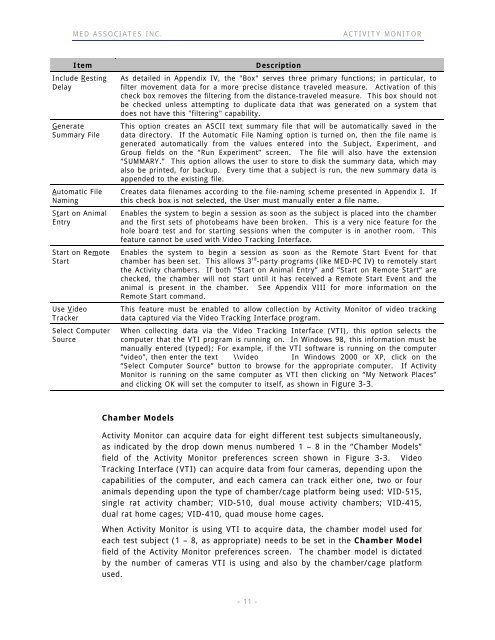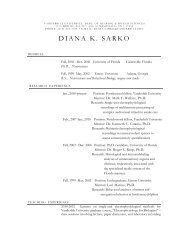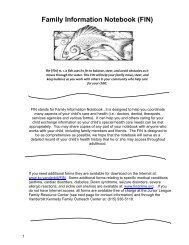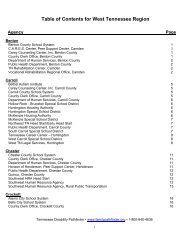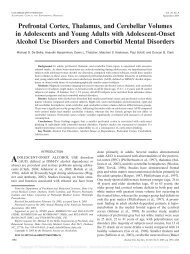ACTIVITY MONITOR - Vanderbilt Kennedy Center
ACTIVITY MONITOR - Vanderbilt Kennedy Center
ACTIVITY MONITOR - Vanderbilt Kennedy Center
Create successful ePaper yourself
Turn your PDF publications into a flip-book with our unique Google optimized e-Paper software.
MED ASSOCIATES INC. <strong>ACTIVITY</strong> <strong>MONITOR</strong><br />
Item Description<br />
Include Resting<br />
Delay<br />
Generate<br />
Summary File<br />
Automatic File<br />
Naming<br />
Start on Animal<br />
Entry<br />
Start on Remote<br />
Start<br />
Use Video<br />
Tracker<br />
Select Computer<br />
Source<br />
As detailed in Appendix IV, the "Box" serves three primary functions; in particular, to<br />
filter movement data for a more precise distance traveled measure. Activation of this<br />
check box removes the filtering from the distance-traveled measure. This box should not<br />
be checked unless attempting to duplicate data that was generated on a system that<br />
does not have this "filtering" capability.<br />
This option creates an ASCII text summary file that will be automatically saved in the<br />
data directory. If the Automatic File Naming option is turned on, then the file name is<br />
generated automatically from the values entered into the Subject, Experiment, and<br />
Group fields on the “Run Experiment” screen. The file will also have the extension<br />
“SUMMARY.” This option allows the user to store to disk the summary data, which may<br />
also be printed, for backup. Every time that a subject is run, the new summary data is<br />
appended to the existing file.<br />
Creates data filenames according to the file-naming scheme presented in Appendix I. If<br />
this check box is not selected, the User must manually enter a file name.<br />
Enables the system to begin a session as soon as the subject is placed into the chamber<br />
and the first sets of photobeams have been broken. This is a very nice feature for the<br />
hole board test and for starting sessions when the computer is in another room. This<br />
feature cannot be used with Video Tracking Interface.<br />
Enables the system to begin a session as soon as the Remote Start Event for that<br />
chamber has been set. This allows 3 rd -party programs (like MED-PC IV) to remotely start<br />
the Activity chambers. If both “Start on Animal Entry” and “Start on Remote Start” are<br />
checked, the chamber will not start until it has received a Remote Start Event and the<br />
animal is present in the chamber. See Appendix VIII for more information on the<br />
Remote Start command.<br />
This feature must be enabled to allow collection by Activity Monitor of video tracking<br />
data captured via the Video Tracking Interface program.<br />
When collecting data via the Video Tracking Interface (VTI), this option selects the<br />
computer that the VTI program is running on. In Windows 98, this information must be<br />
manually entered (typed); For example, if the VTI software is running on the computer<br />
“video”, then enter the text \\video In Windows 2000 or XP, click on the<br />
“Select Computer Source” button to browse for the appropriate computer. If Activity<br />
Monitor is running on the same computer as VTI then clicking on “My Network Places”<br />
and clicking OK will set the computer to itself, as shown in Figure 3-3.<br />
Chamber Models<br />
Activity Monitor can acquire data for eight different test subjects simultaneously,<br />
as indicated by the drop down menus numbered 1 – 8 in the “Chamber Models”<br />
field of the Activity Monitor preferences screen shown in Figure 3-3. Video<br />
Tracking Interface (VTI) can acquire data from four cameras, depending upon the<br />
capabilities of the computer, and each camera can track either one, two or four<br />
animals depending upon the type of chamber/cage platform being used: VID-515,<br />
single rat activity chamber; VID-510, dual mouse activity chambers; VID-415,<br />
dual rat home cages; VID-410, quad mouse home cages.<br />
When Activity Monitor is using VTI to acquire data, the chamber model used for<br />
each test subject (1 – 8, as appropriate) needs to be set in the Chamber Model<br />
field of the Activity Monitor preferences screen. The chamber model is dictated<br />
by the number of cameras VTI is using and also by the chamber/cage platform<br />
used.<br />
- 11 -


